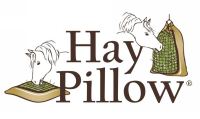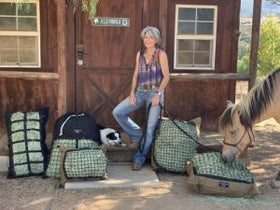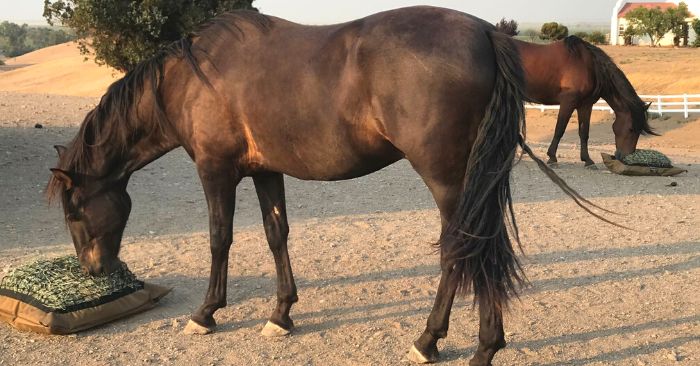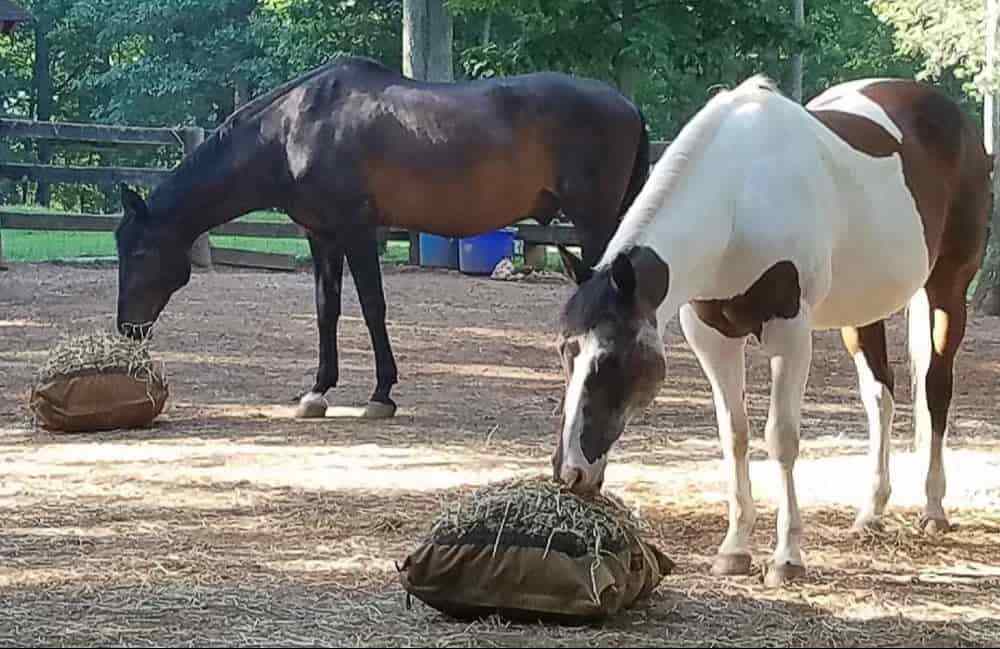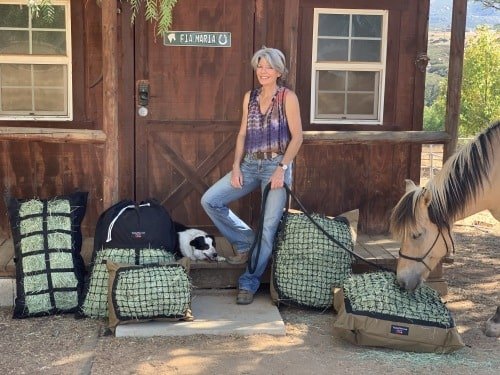9 Benefits of Slow Feeding Horses - Get Slow Feed Savvy
Slow feeding requires the horse to eat smaller amounts over a longer period of time. This concept simulates natural free-choice foraging - and provides a host of benefits you might not be aware of.
Breakfast, lunch, and dinner are meals consumed by humans, but are not natural for a horse. Equines are grazing herbivores with a digestive system designed for - and benefiting from - constant uptake.
If your equine does not have forage available 24/7 - and is fed traditional "meals" - consider implementing a slow-feeding program to keep him nibbling longer. Read on to learn about slow feeder options and the nine ways your horse can benefit from a slow-feed program.

Slow Feeder Options
A slow feeding program can be accomplished by using a variety of slow feeders best suited for the environment in which your horse resides. Offering multiple feeding stations allows and encourages more movement, which helps to simulate natural grazing behavior.
Choices include a bale net or grazing muzzle for pasture time coupled with slow feed hay net bags for ground feeding or hanging bags where feasible in paddocks, corrals, or stalls.
According to Dr. Juliet Getty, independent equine nutritionist:
"Slow-feeders, when used properly, are an excellent way to reduce stress. As their name suggests, they slow down the rate of consumption by providing hay through small openings. When slow feeders are kept full, they allow the horse to graze whenever he wants, thereby encouraging the horse to eat less and still have free access to forage."
Extending or adding meals will not produce the mental and physical health benefits of free-choice forage. To learn more, see our Action Plan: How to Introduce & Incorporate Free Choice Forage.
Are You Slow-Feed Savvy?
Read on to learn of nine slow feeding benefits you may not be aware of......
1. Minimizes periods of fasting
Fasting for more than a few hours induces/worsens Insulin Resistance/Dysregulation in horses. Dr. Juliet Getty graciously expanded on the topic:
"A healthy horse will have cells that are sensitive to insulin. It has been shown that allowing horses to be fed on a regular basis will improve insulin sensitivity. Conversely, withholding feed and/or forage for more than a few hours, will induce insulin resistance, leading to elevated blood insulin levels (hyperinsulinemia). As insulin rises, it tells the fat cells in the body to hold onto the fat. Therefore, restricting forage, for example, can have the opposite intended effect; it can cause the horse to lose muscle and become more obese.”
Equines require a minimum number of healthy calories and nutrient levels (water, fats, carbohydrates, protein, vitamins and minerals) to maintain muscle and achieve optimum thyroid, hormone and immune function. No equine is immune to being malnourished, including overweight individuals.
Even overweight horses should receive a minimum of 1.5% to 2% of their body weight per day in grass hay that is low in non-structural carbohydrates. If appropriate slow fed free-choice forage is available at all times, the diet is balanced and routine exercise implemented they can typically eat more and maintain or lose weight.
2. Reduced risk of ulcers
The equine stomach produces acid 24 hours a day (16 gallons for a 1,000 pound horse) in preparation for constant uptake and can begin to empty in as little as 15-20 minutes. Chewing activates saliva (an alkaline substance) production, which buffers gastric acid. Under natural conditions with free-choice forage, the horse will produce about five gallons of saliva every day and eventually “recycle” much of the water content via re-absorption prior to excretion.
Fiber present in the stomach also prevents the “splashing” of acids. The lower part of the stomach, in addition to producing the acid, receives protection by also producing mucus. The upper, or non-glandular, part has no protection and thus is more susceptible to damage by the acids. The upper portion has squamous epithelium – similar to our skin. Having fiber in the stomach creates a mat of sorts, which is especially crucial during transport and physical activity/exercise causing the splashing of acids.
3. Increased digestion
Optimal digestion and fermentation require time and movement. Mobility stimulates gut motility. Providing forage free-choice in multiple locations will encourage both. This will promote consistent fermentation, effectively keeping the hindgut both weighted (to discourage twisting) and motile, thereby preventing conditions that can contribute to colic. The cecum in a horse has its entrance and exit at the top. Digested material has to defy gravity to exit - the cecum contracts to push the contents out the top. To accomplish this function, forage should be flowing through the digestive system at all times.
If your horse consumes hay too quickly, the particle size will not be reduced sufficiently or have a high enough saliva-to-forage ratio. Saliva plays a crucial role in digestion. Large amounts of dry matter lacking sufficient saliva can contribute to impaction colic.
The primary site for fiber digestion is in the hindgut, which is populated with billions of naturally-occurring, beneficial bacteria and protozoa. However, the hindgut is also home to harmful bacteria. The healthy balance between beneficial and harmful bacteria can easily be disrupted by periods of time without hay or grass intake (fiber). Maintaining a consistent population of beneficial bacteria is essential to ensuring healthy gut function and reducing incidents of hindgut acidosis and laminitis.
The equine cecum serves as a storage site for water and electrolytes. Fiber consumption increases water consumption and the extra water is held in the cecum until absorption. During exercise when dehydration may be an issue, the cecum can help keep the horse hydrated and supply him with electrolytes that are lost in sweat. Bottom line: forage creates a reservoir for fluids in the cecum.
4. Minimized or alleviated boredom
Equines allowed to continuously slow feed benefit psychologically. That is, an occupied horse is less likely to develop vices stemming from boredom or discomfort such as:
- Chewing on inanimate objects
- Cribbing
- Weaving/Pacing
- Self mutation
- Stall kicking
- Pawing
- Eating manure
According to Martine Hausberger, PhD, director of the Laboratory of Animal and Human Ethology, a branch of the French national research center (CNRS) and the University of Rennes:
“It is well-known that horses are trickle feeders that would naturally consume a semi-continuous supply of forage for 40-70% of each 24-hour period....It is also known that horses can experience gastrointestinal discomfort if deprived of food for a mere one to two hours.”
Learn how to give your horse more chew time and bulk without gaining weight. Horses sleep only 3 to 4 hours in a 24-hour period and usually no longer than 20 minutes at one time. Food tends to be their main focus.
5. Natural wear of teeth
Increased chew time wears teeth more naturally when eating at ground level. A natural grazing position allows the mandible (jaw bone) to come down and forward in the atlantoaxial and temporomandibular joints. This enables the mandible to move up and down, side to side, forward and back without any restriction - facilitating optimum mastication and reduction of particle size.
Standard Hay Pillow - Best slow feeder for natural grazing position
6. Little to no wasted hay
Slow feeders prevent horses from trampling hay and contain it in windy conditions. Horses naturally prefer to eat outside in the open, even in windy conditions, because they are prey animals and depend on sight and sound to detect predators. If either of these defenses is impaired, it can create psychological tension. When eating from ground level in an unobstructed area, their peripheral vision is not impaired and they feel more secure and safe.
7. Weight management
Hay is grass with the water reduced. Each mouthful is a more concentrated source of calories. Hay contains seven to eight times more calories than live grass per pound. Grass is 70 to 80% water as opposed to sun cured hay at 5 to 10%. If your horse is overweight, slow feeding will help to regulate insulin spikes and metabolism. For underweight equines, it can help increase digestion and assimilation of calories and nutrients.
8. Elimination of food aggression
Slow feeding with multiple locations enables your entire herd to eat and live together full time by leveling the playing field. The individual that typically consumed the most in the least amount of time will be regulated. If you have an individual that requires additional calories, separate them for additional feedings of soaked hay pellets or complete feeds and allow them to rejoin the herd.
Equines are herd animals. They benefit physically and psychologically from direct physical interaction. Dominant members will keep the others moving as they claim various locations. The less dominant individuals will have alternate sources to eat from - this encourages movement and can decrease cortisol levels associated with stress from being physically separated from herd members.
9. Omission of stress in your life
Meals are stressful to your herd, and you! Equine guardians experience an enormous weight lifted off their shoulders when they are not concerned about feeding times.
Always consider nutrition when dealing with any health or mental issue. Feeding a balanced diet (low in non-structural carbohydrates for overweight individuals) including slow fed free-choice forage is healthiest for your herd. Equines were not designed to thrive on a high-calorie, nutrient-deficient diet comprised of meals. By providing free-choice forage, you will have a healthier, more content herd with the bonus of no longer being committed to multiple feedings day and night!
Additional Benefits of a Natural Grazing Position
- Less strain on the skeletal system and soft tissue because a horse is designed to eat with the head down.
- A natural grazing position allows the mandible (jaw bone) to come down and forward in the atlantoaxial and temporomandibular joints. This enables the mandible to move up and down, side to side, forward and back without any restriction - facilitating natural wear of teeth along with optimum mastication and reduction of particle size.
- Enables nasal passages to drain effectively thereby minimizing the inhalation of dust and particles.
- A horse’s emotional state is reflected in body position and posture. If we require a horse to eat with their head elevated, we are encouraging an alert and tense mental state.
- Eliminates the risk of hay and dust falling into your horse's eyes.
- The Standard Ground Hay Pillows® and Mini Hay Pillows® do not impair the horse's peripheral vision. If impaired, this can create tension psychologically. Horses are prey animals and depend on sight and sound to detect predators.
Learn More from the Experts
For information on insulin resistance, overall nutrition, and balancing a diet to your specific forage, visit these websites:
- Juliet M. Getty, Ph.D. at Getty Equine Nutrition
- Eleanor M. Kellon, VMD at drkellon.com. Dr. Kellon offers classes online to learn how to interpret a hay or pasture analysis and formulate a custom mix balanced to that specific forage.
Helpful How-to Resources for Slow Feeding
- 7 Slow Feed Dos and Dont's for Horses
- Horse Slow Feeder Safety Tips
- Slow Feeding - Transition Tips & Techniques
- Choosing a Mesh Size
- Slow Feed Solutions by Enclosure Type & Weather Condition
- How I Chose the Best Slow Feeder for My Horse
- Sand Colic - The Surprising (Simple) Cure & Prevention
- Can Horses Eat More Hay Without Weight Gain? The Surprising Factors
- How to Introduce & Incorporate Free-Choice Forage: An Action Plan
- 7 Easy Ways to Help Prevent Colic
- Why Most Horse Prefer to Eat Outside
- Horse Boredom Busters - Toys & Enrichment Tips for Stall or Pasture
References:
- Freedom Health, LLC (2011, August). Colic, Colonic Ulcers and the Equine Digestive Tract. Retrieved from https://www.succeed-vet.com/wp-content/uploads/2013/09/Freedom-Health-Colic-Whitepaper.pdf
- Getty, J. M. Ph.D. Free-Choice Forage Feeding – Beyond the Basics. Retrieved from https://gettyequinenutrition.com/pages/free-choice-forage-feeding-beyond-the-basics
- Getty, J. M. Ph.D. Horse Digestion - It's Decidedly Different! Retrieved from https://gettyequinenutrition.com/products/equine-digestion-book
- Ridgway, K. J. DVM (2011). Equine Ulcers – You Really Need To Know More! Retrieved from https://drkerryridgway.com/2016/07/05/equine-ulcers/
